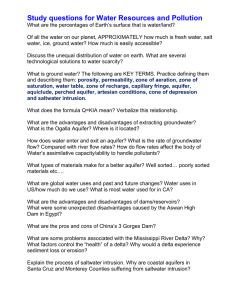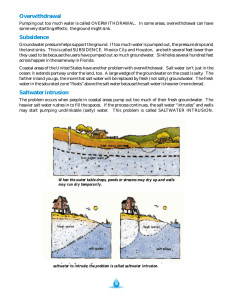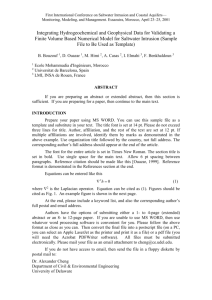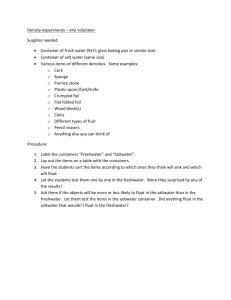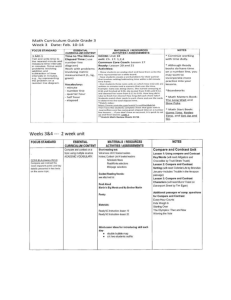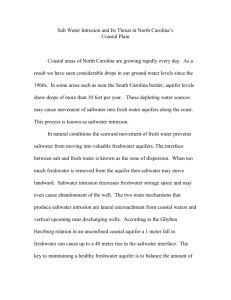Saline Water Intrusion
advertisement
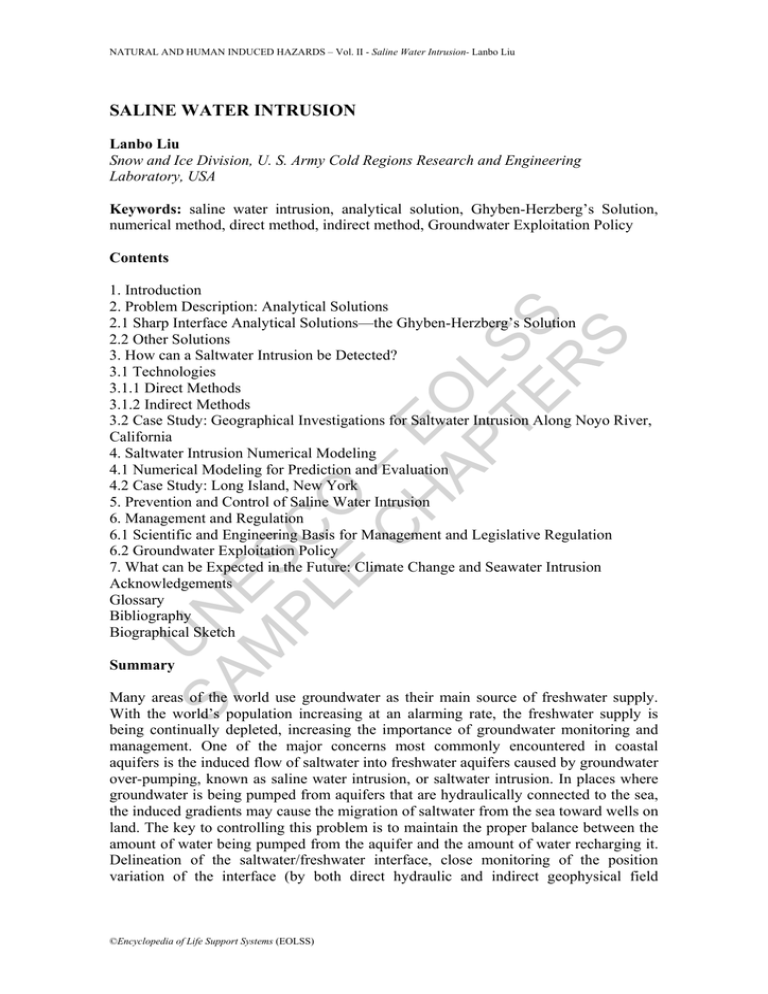
NATURAL AND HUMAN INDUCED HAZARDS – Vol. II - Saline Water Intrusion- Lanbo Liu SALINE WATER INTRUSION Lanbo Liu Snow and Ice Division, U. S. Army Cold Regions Research and Engineering Laboratory, USA Keywords: saline water intrusion, analytical solution, Ghyben-Herzberg’s Solution, numerical method, direct method, indirect method, Groundwater Exploitation Policy Contents U SA N M ES PL C E O– C E H O AP L TE SS R S 1. Introduction 2. Problem Description: Analytical Solutions 2.1 Sharp Interface Analytical Solutions—the Ghyben-Herzberg’s Solution 2.2 Other Solutions 3. How can a Saltwater Intrusion be Detected? 3.1 Technologies 3.1.1 Direct Methods 3.1.2 Indirect Methods 3.2 Case Study: Geographical Investigations for Saltwater Intrusion Along Noyo River, California 4. Saltwater Intrusion Numerical Modeling 4.1 Numerical Modeling for Prediction and Evaluation 4.2 Case Study: Long Island, New York 5. Prevention and Control of Saline Water Intrusion 6. Management and Regulation 6.1 Scientific and Engineering Basis for Management and Legislative Regulation 6.2 Groundwater Exploitation Policy 7. What can be Expected in the Future: Climate Change and Seawater Intrusion Acknowledgements Glossary Bibliography Biographical Sketch Summary Many areas of the world use groundwater as their main source of freshwater supply. With the world’s population increasing at an alarming rate, the freshwater supply is being continually depleted, increasing the importance of groundwater monitoring and management. One of the major concerns most commonly encountered in coastal aquifers is the induced flow of saltwater into freshwater aquifers caused by groundwater over-pumping, known as saline water intrusion, or saltwater intrusion. In places where groundwater is being pumped from aquifers that are hydraulically connected to the sea, the induced gradients may cause the migration of saltwater from the sea toward wells on land. The key to controlling this problem is to maintain the proper balance between the amount of water being pumped from the aquifer and the amount of water recharging it. Delineation of the saltwater/freshwater interface, close monitoring of the position variation of the interface (by both direct hydraulic and indirect geophysical field ©Encyclopedia of Life Support Systems (EOLSS) NATURAL AND HUMAN INDUCED HAZARDS – Vol. II - Saline Water Intrusion- Lanbo Liu surveys), water usage forecasting through computer modeling, hydraulic modification through artificial and/or enhanced natural recharge are the four fundamental components of efficient countermeasures for the saline water intrusion. Global climate change and the associated sea level rise may worsen the case and induce more severe saline water intrusion. The major purpose of groundwater resource management and legislation in coastal regions should be the safeguarding of a sustainable social and economic development. 1. Introduction U SA N M ES PL C E O– C E H O AP L TE SS R S Water is one of the most important natural resources to a life support system. The hydrosphere on the surface and near-surface of Earth is the basis for all the living species on this planet. Nevertheless, the apparent relative abundance of water available to mankind makes people easily forget its importance and irreplaceability to their lives. In the land hydraulic system, when the fresh groundwater is withdrawn by pumping wells at a faster rate than it can be replenished, a draw-down of the water table occurs with a resulting decrease in the overall hydrostatic pressure. When this happens near an ocean coastal area, saltwater from the ocean intrudes into the freshwater aquifer (Figure 1). The result is that freshwater supplies become contaminated with saltwater, as is happening to some coastal communities such as those along the Atlantic and Gulf coasts in the United States. This is the commonly understood definition of saline water intrusion. Saline water intrusion, or encroachment, is defined in a more professional way by Freeze and Cherry (1979) as “the migration of saltwater into freshwater aquifers under the influence of groundwater development.” Atkinson (1986) details saltwater intrusion problems for the coastal areas of the United States. Saline water intrusion may also include the saltwater wedge in the surface water area in coastal river systems, as well as saltwater in eustatic wetlands. This type of intrusion has great impact on the ecological systems in these regions, such as the Mississippi River delta near New Orleans, Louisiana. Our main concern in this article, however, is the groundwater system with saline water intrusion into freshwater aquifers. ©Encyclopedia of Life Support Systems (EOLSS) NATURAL AND HUMAN INDUCED HAZARDS – Vol. II - Saline Water Intrusion- Lanbo Liu Figure 1. Sketch of the concept of saline water intrusion The encroachment of saltwater into freshwater supplies has become cause for concern within the last couple of centuries as populations in coastal areas have risen sharply and placed greater demands on fresh groundwater reserves. Saltwater intrusion causes many ecological, environmental, social, and economic problems in those coastal areas. Although that impact of saltwater intrusion has only been recognized for a relatively short period, the outcome of this problem could be very severe in the future. U SA N M ES PL C E O– C E H O AP L TE SS R S The limited potable drinking water supply could be one of the most serious problems to a life support system. Drinking water standards established by the US Environmental Protection Agency (USEPA) in 1962 require that drinking water contain no more than 500 mg/L of total suspended solids (TSS), a common measure of salinity (Atkinson, 1986). Seawater contains approximately 30000 mg/L of TSS, 60 times higher than the USEPA standard for drinking water. Therefore, it is evident that even a small amount of seawater can cause problems when mixed with freshwater reservoirs. Also, salinity in irrigation water can be detrimental to agriculture, reducing yields and killing crops with low tolerances to salt. This article aims to describe the saline water intrusion problem in layman’s terms. It tries to approach the task from several directions. First, a description of the problem is provided, with the aid of the quantitative representation by a simple analytical model. Then, the article explains how to detect the intrusion and how to prevent the occurrence of the problem. Management and policy issues will also be discussed towards the end of the article. In the following section, the analytical solutions are used to explain the fundamental concepts of the physical problem of saline water intrusion. 2. Problem Description: Analytical Solutions In any physical science discipline, an analytical solution can often provide a relatively simple but clear concept of the problem. The development of analytical solutions also lends readers a historic perspective of the progress of special fields such as seawater intrusion theory. Analytical solutions can also be used as benchmarks for numerical solutions. More importantly, engineers frequently use an analytical solution as the tool of a first-cut assessment for locations where hydrogeological information is limited. Due to the page limit of an EOLSS article, the coverage of this section is not intended to be exhaustive. Only selected solutions will be presented. In particular, analytical solutions that are mathematically complicated, and/or require extensive numerical calculation, are excluded. This section starts with the discussion of the sharp interface solution, which is the most important formula to understand the saltwater intrusion problem. 2.1 Sharp Interface Analytical Solutions—the Ghyben-Herzberg’s Solution The Ghyben-Herzberg Relation is the first and most fundamental analytical model to describe the saltwater intrusion problem. The Ghyben-Herzberg Relation states that under hydrostatic conditions, the weight of a unit column of freshwater extending from ©Encyclopedia of Life Support Systems (EOLSS) NATURAL AND HUMAN INDUCED HAZARDS – Vol. II - Saline Water Intrusion- Lanbo Liu the water table to the interface is balanced by a unit column of saltwater extending from sea level to the same depth as the point on the interface (Figure 2). This could be mathematically expressed as: hf = ρs − ρ f hs ρf (1) U SA N M ES PL C E O– C E H O AP L TE SS R S where hf is the elevation difference between the phreatic surface (the groundwater table) and the sea level; hs is the elevation difference between the sea level and the sea waterfreshwater interface at a given point. ρ s and ρ f are the density of the sea water and freshwater, respectively. The Ghyben-Herzberg Relation can also be expressed by the elevation of the interface from the bottom of the aquifer Z by Z= 1 (ρ H − ρ f φ ) ρs − ρ f s s (2) where the total head φ is elevation of the groundwater table; Hs is the thickness of seawater from the impermeable aquiclude. φ = hf + H s (3) Figure 2. The Ghyben-Herzberg analysis for the seawater-freshwater interface ©Encyclopedia of Life Support Systems (EOLSS) NATURAL AND HUMAN INDUCED HAZARDS – Vol. II - Saline Water Intrusion- Lanbo Liu This analysis assumes hydrostatic conditions in a homogeneous, unconfined coastal aquifer. How deep the seawater can intrude towards the land depends on the gradient of the phreatic surface ascending from the sea level. If the seawater density is 1.025 gram/cc and the freshwater density is 1.0 gram/cc, according to the Ghyben-Herzberg relation, if the water table in an unconfined coastal aquifer is lowered by 1 m, the saltwater interface will rise about 40 m. Apparently, this can result in a tremendous loss of freshwater resources. This value will vary from place to place, depending upon the density contrast between the seawater and the freshwater. U SA N M ES PL C E O– C E H O AP L TE SS R S Badon Ghyben and A. Herzberg independently derived the above relation now known as the Ghyben-Herzberg equation in 1888 and 1901, respectively. It is of interest to note that Du Commun should really be credited with the discovery of this relation in 1828. It is easy to prove that the Ghyben-Herzberg relation is equally valid for a unconfined aquifer, whose upper boundary is a phreatic surface, and a confined aquifer whose upper boundary is a horizontal impermeable layer. In the latter case hf represents the piezometric head with respect to the sea level. In practice, the Ghyben-Herzberg relation and modified Ghyben-Herzberg (which uses the observed piezometric head in the saltwater zone) method cab be used for a preliminary estimate of the location of the saltwater-freshwater interface. The procedure for estimation is as follows: (a) Collect piezometric head data and use statistic kriging to plot contour maps; (b) Contour maps showing the elevation of saltwater/freshwater interface can be obtained by the Ghyben-Herzberg relation; (c) Collect geological information that marks aquifer bottom boundary; (d) Thee intersection of the interface and aquifer bottom can be traced and the “toe” location of the saltwater wedge can be delineated. 2.2 Other Solutions The Ghyben-Herzberg theory is only the beginning of many more attempts to analytically understand the saltwater intrusion problem. After the effort started in the nineteenth century, researchers have continuously worked on this problem. In contrast to the idealized hydrostatic conditions represented in the Ghyben-Herzberg theory, Hubbert solved the seawater-freshwater interface problem under a more realistic steadystate flow condition in 1940. In 1954 Keulegan developed the tilting interface solution. Bear and Dagan worked on the moving interface solution. Dupuit worked on transient location of interface due to sudden change of flow rate. Dagan and Bear developed the upconing solution assuming that the upconing of the interface is due to a point sink, and used the perturbation technique to reach the solution. As the modeling progressed, people realized the importance of the concept of Critical Pumping Rate. Wirojanagud and Charbeneau (1985), and Motz (1992) formulated the expression for critical pumping rate. When the saltwater prevention and control has been on the stage for coastal hydrogeological engineering, flow modeling with recharge sources has also been developed. Hantush (1968) developed the recharge strip solution. Strack (1976) developed the single potential solution. ©Encyclopedia of Life Support Systems (EOLSS) NATURAL AND HUMAN INDUCED HAZARDS – Vol. II - Saline Water Intrusion- Lanbo Liu Some more complicated models have been developed to handle the miscible transport analytical solutions (e.g. Henry 1964). In the last two decades, more complicated numerical modeling techniques using finite difference and finite element algorithms have also been developed. A brief description of these modeling techniques, as well as case study examples, will be given in the section on numerical modeling. 3. How Can a Saltwater Intrusion be Detected? U SA N M ES PL C E O– C E H O AP L TE SS R S To detect the existence of saltwater in aquifers where saline water contamination is suspected, two major types of techniques can be deployed: direct methods and indirect methods. The direct methods use direct physical and chemical measurements of water and/or soil samples obtained from wells or monitoring boreholes, whereas the indirect methods take advantage of geophysical surveys conducted on the Earth’s surface or in boreholes to infer the subsurface conditions in the formations. Methods and instrumentation associated with chemical analysis of groundwater samples and the determination of flow patterns in boreholes can be regarded as the direct methods. Subsequently, geophysical methods of investigation, which are the major constituents of indirect methods, have become more important. Using geophysical methods, more information could be obtained relatively inexpensively and faster than by using drilling techniques. Moreover, it is a kind of volume measurement (with relatively larger uncertainties), other than the point measurement (with higher accuracy) deployed by drilling or direct push methods. This section first briefly describes the direct methods, and then it discusses the indirect geophysical approaches in detail. - - TO ACCESS ALL THE 29 PAGES OF THIS CHAPTER, Click here Bibliography Atkinson S. F., Miller G., Curry D., and Lee S. (1986). Salt Water Intrusion, Environmental and Ground Water Institute, University of Oklahoma, Norman, OK, USA: Lewis Publishers. [This book discusses the fundamentals of saltwater intrusion problems.] De Breuck W. (1991). Hydrogeology of Saltwater Intrusion: Methods and Instruments, 223 pp. Hanover, Germany: Verlag Heinz Heise GmbH & Co KG. [This is another book that discusses the saltwater intrusion problems.] Driscoll F. G. (1986). Groundwater and Wells: Control of Saltwater Intrusion, 773 pp. St. Paul, Minnesota, USA: Johnson Division. [This book discusses the saltwater intrusion problems with theories and applications.] Freeze R. A. and Cherry J. A. (1979). Groundwater, Englewood Cliffs, NJ, USA: Prentice Hall. [This is a widely used textbook discusses groundwater studies with applications to many geological problems including saltwater intrusion.] ©Encyclopedia of Life Support Systems (EOLSS) NATURAL AND HUMAN INDUCED HAZARDS – Vol. II - Saline Water Intrusion- Lanbo Liu Kontis A. L. (1998). Simulation of Freshwater-Saltwater Interfaces in the Brooklyn-Queens Aquifer System, Long Island, New York. US Geological Survey Water-Resources Investigation Report 98-4067. [This report presents the numerical simulation results of saltwater intrusion in Long Island, New York using the finite difference technique.] Newport B. D. (1977). Salt Water Intrusion in the United States, EPA-600/8-77-011. Environmental Protection Agency, Ada, Oklahoma. [This document provides an excellent review on this topic before the 1970s.] Sheriff R. E. and Geldart L. P. (1995). Exploration Seismology, 592 pp. Cambridge University Press, Cambridge, U.K. [This is a widely used textbook on exploration seismology with applications mainly on petroleum resources explorations.] U SA N M ES PL C E O– C E H O AP L TE SS R S Strack O. D. L. (1989). Groundwater Mechanics, 732 pp. Englewood Cliffs, NJ, USA: Prentice Hall. [This presents the fundamentals of groundwater mechanics and discusses a number of typical cases of saltwater intrusion using analytic solutions.] Biographical Sketch Lanbo Liu Education: PhD in Geophysics, Stanford University, 1993 MS in Civil Engineering, Stanford University, 1992 MS in Geophysics, Stanford University, 1990 MS in Geophysics, Peking University, 1981 BS in Geophysics, Peking University, 1978 Professional Experience: 09/01-present Research Geophysicist, Cold Regions Research and Engineering Laboratory 09/95-08/01 Assistant Professor of Geophysics, University of Connecticut 11/93-08/95 Carnegie Fellow (postdoctoral), Department of Terrestrial Magnetism, Carnegie Institution of Washington 09/88-10/93 Research Assistant, Dept. of Geophysics, Stanford University 09/87-08/88 Research Assistant, Center for Earthquake Research and Information, University of Memphis 11/81-08/87 Geophysicist and Project Chief, Center for Analysis and Prediction, China Seismological Bureau (CSB) 03/78-09/78 Geophysicist, Beijing Seismological Bureau ©Encyclopedia of Life Support Systems (EOLSS)
